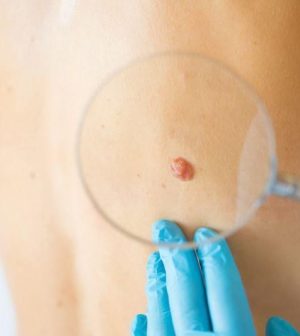- See What Saffron Can Do for Sleep and Heart Health
- 6 Common Mistakes to Avoid Before Your Physical
- Can Sweating Really Help You Beat a Cold?
- Strengthening Your Relationship: Practical Strategies
- Skip Storing This Everyday Product in the Fridge Door
- Green Tea + B3 Pairing May Boost Brain Health
- Navigating Your Midlife Crisis: Embracing New Possibilities
- City Raccoons Showing Signs of Domestication
- Mapping the Exposome: Science Broadens Focus to Environmental Disease Triggers
- One Week Less on Social Media Linked to Better Mental Health
Melanoma: What It Is, Causes, Types, Symptoms & Treatments

Of all the skin cancers, melanoma is the one that scares doctors and patients the most.
Luckily, there are now several options for treatment should you be diagnosed with this aggressive, sometimes deadly, cancer.
Melanoma affects over 1 million Americans, and its rates have risen significantly in the past 30 years, according to the American Academy of Dermatology (AAD).
Here, experts explore what melanoma is, along with its causes, risk factors and key symptoms. Plus, you’ll learn about melanoma’s stages, types and treatments.
What is melanoma?
The American Cancer Society (ACS) explains that cancer occurs when cells begin to grow out of control. Melanoma is a type of cancer that starts in the pigment-making cells, known as “melanocytes.” While not as common as other forms of skin cancer, it is more serious.
“Melanoma is more aggressive and more likely to spread to the lymph nodes,” said Dr. Hugh Greenway, a dermatologic surgeon with Scripps MD Anderson Cancer Center and Scripps Clinic in California. “It’ll spread to the liver, to the brain and throughout the body if not checked.”
According to the AAD, ultraviolet light from the sun or tanning beds is the cause of melanoma.
Risk factors include:
- Blistering sunburns
- Tanning bed use
- Light skin, light-colored eyes, or red or blond hair
- Moles that are asymmetrical or large
- Time in the sun without protection
- Numerous moles (50 or more)
- Being age 50 or older
- A family history of melanoma
- Lowered immunity
- A thyroid, breast or previous skin cancer diagnosis
To reduce these risks, Greenway recommended wearing sunglasses, a wide-brimmed hat and using a water-resistant sunscreen that protects against both UVB and UVA light when out in the sun.
“I tell my patients here at Scripps between a 30 to 50 [SPF sunscreen] is fine,” he advised.
Melanoma types
The Skin Cancer Foundation lists four main types of melanoma:
- Superficial spreading melanoma is the most common type and tends to occur on the upper back, the legs for women and the torso for men
- Lentigo maligna melanoma tends to occur in older adults and often shows up on the arms, upper torso, face and ears
- Acral lentiginous melanoma is the most common type for people of color and mostly occurs on the soles of the feet, palms and under the nails
- Nodular melanoma is considered the most aggressive type and typically occurs on the arms, legs, torso and scalp in older men
Melanoma symptoms
So, what does melanoma look like?
Scripps MD Anderson Cancer Center says to be on the lookout for irregular-looking spots on your skin, new spots or ones that change size, shape or color.
Other melanoma symptoms may include:
- Fluid (like blood or puss) on a spot’s surface
- Itching, redness or pain
- New inflammation outside the spot’s original borders
- Color (pigmentation) that spreads to surrounding areas
- A spot that won’t heal
To help you identify a melanoma, Greenway suggests the A-B-C-D-E rule.
“’A’ stands for asymmetry,” he explained. If you draw a line down the middle of a melanoma spot or mole, one half won’t typically match the other.
The “B” is borders that aren’t regular. “That one [mole] that’s got a lot of outcropping and things, we say that’s a little irregular,” he noted.
“C” stands for color. “All of a sudden if you’ve got a mole that’s got a lot of blacks in it, reds, different colors, that could be a sign that mole’s a problem. ‘D’ is just for being different, and ‘E’ is for a mole that’s sort of starting to evolve and change a little bit.”
He advised that itchy moles or ones you’re suddenly aware of could be early signs of melanoma, while bleeding moles may indicate more advanced stages of the disease.
Stages of melanoma
According to the ACS, the stages of melanoma are:
- Stage 0: The cancer is only on the skin’s outer layer
- Stage I: The tumor is less than 2 mm thick and hasn’t spread beyond the skin
- Stage II: The tumor is at least 1 to 4 mm thick and hasn’t spread beyond the skin
- Stage III: The primary tumor can vary in size or not be visible, and the cancer has spread to nearby lymph nodes or areas of the skin
- Stage IV: The tumor has spread to distant lymph nodes or organs
Melanoma treatments
Scripps states that melanoma treatments include:
- Surgery to remove the cancer
- Chemotherapy and radiation
- Immunotherapy drugs
- Targeted gene and protein therapy
One study published recently in the journal Cancer Discovery found that certain mRNA vaccines combined with immunotherapy helped reduce the risk of melanoma tumors returning, although more research is needed before this treatment is broadly available.
Early detection is also key to better melanoma outcomes, according to Greenway.
“You probably ought to have your skin checked once a year,” he recommended. “We know that if we can make the diagnosis [early], we can cure it with greater than 99% [cure rate] in most people.”
Source: HealthDay
Copyright © 2025 HealthDay. All rights reserved.










